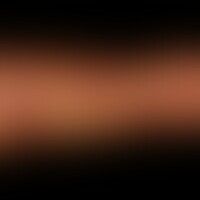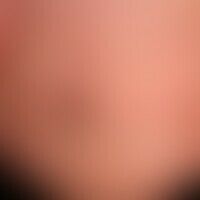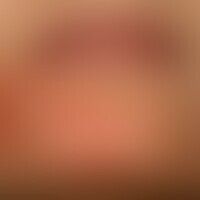
Balanitis plasmacellularis N48.1
Balanitis plasmacellularis: chronic balanitis in a 61 year old patient. rather discreet findings. no other skin diseases known. no diabetes mellitus. slight urinary incontinence. several blurred, slightly raised red plaques. no significant symptoms.

Erythema migrans A69.2
Erythema chronicum migrans: anular erythema that has been developing for several weeks, completely without symptoms.
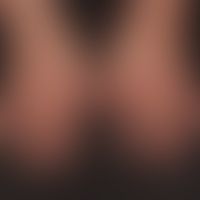
Dermatomyositis (overview) M33.-
Dermatomyositis (overview): Striped arrangement of red papules and plaques, which confluent to flat areas in the area of the end phalanges; strongly pronounced nail fold capillaries.
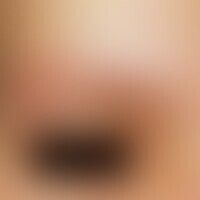
Ulerythema ophryogenes L66.4
Ulerythema ophryogenes. extensive erythema with (scarred) raeration of the eyebrows. between the still persistent eyebrows are dense, fine, hairless follicular papules.

Vasculitis leukocytoclastic (non-iga-associated) D69.0; M31.0
Vasculitis leukocytoclastic (non-IgA-associated): small spotted vasculitis of both lower legs; multiple red spots (redness cannot be suppressed).
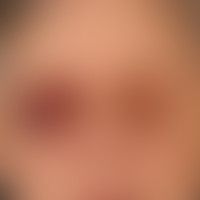
Al amyloidosis skin changes E85.9
AL-amyloidosis in smoldering myeloma. 77-year-old patient with recurrent ecchymosis of the periorbital region, clinically corresponding to a hematoma of the eyeglasses. These characteristic skin lesions are called "raccoon sign". Further purple skin lesions are found in the neck and retroauricularly. The bone marrow biopsy showed a smoldering myeloma (infiltration of plasma cells at 15%).
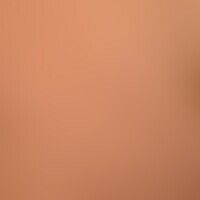
Teleangiectasia macularis eruptiva perstans Q82.2
Teleangiectasia macularis eruptiva perstans: discrete, moderately itchy, disseminated, 0.2-0.5 cm large, roundish, red or reddish-brown spots interspersed with telangiectasia; urticarial reaction when rubbed vigorously over the spot (Darier's sign).

Dermatomyositis (overview) M33.-
Dermatomyositis: Flat red plaques on the end phalanges. Hyperkeratotic nail folds

Nail hematoma T14.05
haematoma, nail haematoma. nail alteration after slight crush trauma. striped, red and blue-black spots (splinter hemorrhages). since red and black shades are present at the same time, this finding speaks against a melanotic pigmentation.

Phototoxic dermatitis L56.0
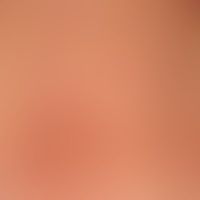
Teleangiectasia macularis eruptiva perstans Q82.2
Teleangiectasia macularis eruptiva perstans. 58-year-old patient with a generalized, flekc-shaped clinical picture which has existed for years and shows a constant progression. itching during sweat-inducing efforts and mechanical exposure of the affected skin areas. close-up with bizarre teleangiectatic vessel convolutions.

Purpura thrombocytopenic M31.1; M69.61(Thrombozytopenie)
Purpura thrombocytopenic: Hemorrhagic spots with a tendency to confluence, existing on both lower legs with emphasis on the extensor sides. It is a drug-induced form of a thrombotic- thrombocytopenic purpura with hemolytic microangiopathic anemia and central nervous failure symptoms. The trigger was the ingestion of non-steroidal anti-inflammatory drugs. Sudden onset with fever, disorientation, stupor.

Erythronychia longitudinalis; L60.9 L60.8
Erythronychia, localized longitudinal detail magnified by reflected light microscopy; solitary, painless, red longitudinal striation of the nail plate with slight, V-shaped retraction and several splinter hemorrhages.

Mononucleosis infectious B27.9
mononuleosis, infectious. generalized (almost universal) macular exanthema. raspberry tongue with swollen papillae. tongue surface completely free of coating.
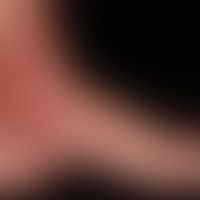
Vasculitis leukocytoclastic (non-iga-associated) D69.0; M31.0
Vasculitis leukocytoclastic (non-IgA-associated): multiple, for about 10 days existing, localized on both lower legs, irregularly distributed, 0.1-0.2 cm large, confluent in places, symptomless, red, smooth spots (not compressible).

Atopic erythrodermal dermatitis L20.8
Eczema atopic (erythrodermal): severe, universal (erythrodermal) atopic eczema, exacerbation phase for about 3 months.
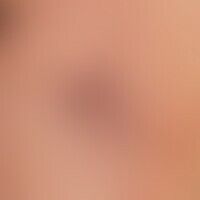
Varice reticular I83.91

Henoch-Schoenlein purpura D69.0
Purpura Schönlein-Henoch. seeding of smallest petechiae beside fresh and older haemorrhagic maculae.

Tinea inguinalis B35.6
Tinea inguinalis: plaques that have existed for several months, coarse lamellar scaling and moderately itchy. Mycological evidence of T. rubrum.
